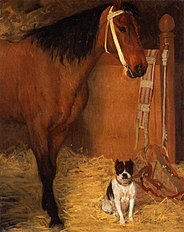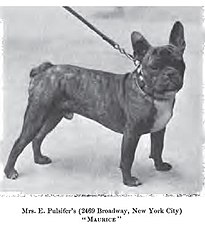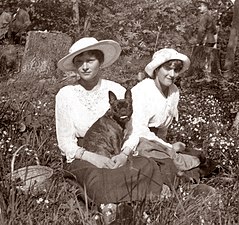French Bulldog
The examples and perspective in this article deal primarily with the United States and do not represent a worldwide view of the subject. (November 2021) |
| French Bulldog | |||||||||||||||||
|---|---|---|---|---|---|---|---|---|---|---|---|---|---|---|---|---|---|
 | |||||||||||||||||
| Other names | Bouledogue Français | ||||||||||||||||
| Origin | France[1] | ||||||||||||||||
| |||||||||||||||||
| |||||||||||||||||
| Dog ( domestic dog ) | |||||||||||||||||
The French Bulldog (
History
From the beginning of the nineteenth century,
At the same time, lace workers from Nottingham who were displaced by the Industrial Revolution began to settle in Normandy, France.[5]: 58 They brought a variety of dogs with them, including Toy Bulldogs.[6] The dogs became popular in France and a trade in imported small Bulldogs was created, with breeders in England sending over Bulldogs that they considered to be too small, or with faults such as ears that stood up. By 1860, there were few Toy Bulldogs left in England, such was their popularity in France.[4]: 6
The small Bulldog type gradually became thought of as a breed, and received a name, the Bouledogue Francais.[4]: 6 This Francization of the English name is also a contraction of the words boule ('ball') and dogue ('mastiff'). The dogs were highly fashionable and were sought after by society ladies and Parisian prostitutes alike, as well as creatives such as artists, writers, and fashion designers.[4]: 6 The artists Edgar Degas and Henri de Toulouse-Lautrec are thought to have French Bulldogs in their paintings.[7] However, records were not kept of the breed's development as it diverged further away from its original Bulldog roots. As it changed, terrier stock had been brought in to develop traits such as the breed's long straight ears.[4]: 6
Depictions in nineteenth-century paintings
-
Toulouse-Lautrec: Bouboule, Bull-dog de madame Palmyre, à la souris, 1897
-
A l'écurie, cheval et chien, Edgar Degas, about 1861
-
Toulouse-Lautrec
-
Toulouse-Lautrec
Breed clubs and modern recognition
Americans had been importing French Bulldogs for a while, but it was not until 1885 that they were brought over in order to set up an American-based breeding program. They were mostly owned by society ladies, who first displayed them at the
This new Bulldog breed arrived for the first time in England in 1893, with English Bulldog breeders in an uproar as the French imports did not meet the new breed standards in place by this time, and they wanted to prevent the English stock from crossbreeding with the French. The Kennel Club initially recognized them as a subset of the existing Bulldog breed rather than an entirely new breed.[4]: 6 Some English breeders in this period bred the French Bulldogs in order to resurrect the Toy Bulldog.[5]: 58 On 10 July 1902, at the house of Frederick W. Cousens, a meeting was held to set up a breed club in order to seek individual recognition for the French breed.[4]: 7 The adopted breed standard was the same one which was already in use in America, France, Germany and Austria.[5]: 58 Despite opposition from Miniature Bulldog (the new breed name for the Toy Bulldog) and Bulldog breeders,[5]: 59 in 1905, the Kennel Club changed its policy on the breed and recognized them separate from the English variety, initially as the Bouledogue Francais, then in 1912 as the French Bulldog.[4]: 7
Today the French Bulldog is commonly kept as a pet: in 2020, it was the second-most registered dog in the United Kingdom,[10] and the fourth-most in the United States.[11] They were rated the third-most popular dog in Australia in 2017.[12] In 2019, in the United Kingdom, the French Bulldog had a total of 33,661 registered dogs.[13] By comparison, the Labrador Retriever had over 36,700 dogs and the Cocker Spaniel fewer than 22,000. In 2013, the American Kennel Club (AKC) ranked the French Bulldog as the 10th most popular breed in the United States, enjoying a sharp rise in popularity from 54th place a decade before, in 2003.[14] In 2023, the French Bulldog overtook the Labrador as the most popular breed of dog as ranked by the AKC. Before 2023, Labradors had held the top spot for 31 years.[15]
Historic photographs
-
1890
-
1901, Maurice in New York City
-
1908, Anna Sacher
-
1911, Ch. Stanmore Argus
-
1915
-
between 1875 and 1917
-
1917 with Grand Duchesses Tatiana and Anastasia Nikolaevna of Russia
Description
The American Kennel Club standard for the French Bulldog states that it should be muscular, with a soft and loose coat forming wrinkles.[6]
The AKC Standard weight for a French Bulldog is at maximum 28 pounds (13 kg).
-
Brindle
-
Pied
-
Cream
-
Fawn
-
Black
-
Gray
Health


A study in the UK comparing French Bulldogs to the general canine population found that of 43 common conditions, the French Bulldog had significantly higher prevalence for almost half (20/43) and a significantly lower prevalence for a quarter (11/43).
In 2013, a UK Medical Study reviewed the health of 2228 French Bulldogs under veterinary care in the UK. The study found that 1612 (72.4%) of these French Bulldog had at least one recorded health issue: The most common disorders recorded were ear infections (14.0%), diarrhea (7.5%) and conjunctivitis (3.2%). Skin problems were the most commonly reported group of disorders (17.9%).[20]
Despite these challenges, the popularity of French Bulldogs continues to rise, emphasizing the importance of addressing their health issues.[21][22]
Brachycephaly
The shortened snout and pushed in face of the French Bulldog is known as
Life expectancy
A study of the deaths of 30,563 dogs of different breeds in the United Kingdom in 2016–2020 found the French Bulldog to have a life expectancy at birth of 4.53 years, the lowest by a large margin of all breeds in the study, which found an average for all dogs of 11.23 years.[36]: 1 This same study indicates that the low life expectancy for French Bulldogs is possibly influenced by the increasing number of French Bulldogs present in the UK, increasing from 2,771 KC registered individuals in 2011 to 39,266 individuals in 2020, skewing the general population to be very young on average and biasing the data.[36]: 1 A Japanese study of pet cemetery data found the French Bulldog to have a life expectancy of 10.2 years, the lowest of all breeds in the study.[37][a] A 2024 UK study found a life expectancy of 9.8 years for the breed compared to an average of 12.7 for purebreeds and 12 for crossbreeds.[38]
Birth and reproduction
French Bulldogs frequently require Caesarean section to give birth, with over 80% of litters delivered this way.[39][40]
A UK study identified French Bulldog bitches to be 15.9 times more likely to experience dystocia.[41]
Orthopaedics
French Bulldogs are prone to having congenital
A review of more than 200,000 patients in the UK found that French Bulldogs had a noticeably higher occurrence of
Other conditions
A French study found that 45% of French Bulldogs presenting with a neurological condition had Hansen type I intervertebral disk herniation, with the study concluding that the French Bulldog is prone to the condition.[46]
A UK study found the French Bulldog to be more likely to suffer from thoracic vertebral malformations than other breeds.[47]
A British study found demodicosis to be more prevalent in the French Bulldog than other breeds. The overall prevalence in French Bulldogs was 1.3% compared to the overall rate of 0.17%. The prevalence in dogs under the age of 2 years was 1.9% compared to 0.48%.[48]
The French Bulldog is one of the most commonly affected breeds for hereditary cataracts.[49]
Notes
- ^ The Japanese study reviewed cemetery data which is unlikely to have any records of still-births and altricial deaths whilst a veterinary clinic likely would have some data on these.
References
- ^ "Bouledogue Français" [French Bulldog]. FCI breeds nomenclature (in French and English). Fédération Cynologique Internationale. 101. Retrieved 15 November 2021.
- ^ a b c d Bouledogue Français [French Bulldog] (PDF) (Report). FCI Standard (in French and English). Fédération Cynologique Internationale. N° 101 g09 / en. Retrieved 15 November 2021.
- ^ "Le bouledogue Français, Ses origines", 'Official breed club created in 1898 (fr)'
- ^ a b c d e f g h i j k
Coile, D. Caroline (2005). French Bulldogs. Hauppauge, NY: Barron's. ISBN 9780764130311 – via Internet Archive(archive.org).
- ^ a b c d Robert, Leighton (1907). The New Book of the Dog. London, UK / New York, NY: Cassell – via Internet Archive (archive.org).
- ^ a b "Get to Know the French Bulldog", The American Kennel Club, retrieved 28 May 2014.
- ^ "French Bulldog Dog Breed Information". American Kennel Club. Retrieved 31 January 2020.
- ^
"A Sacramento heiress and [a] murder on the French bulldog express". Looking back. Sacramento News & Review. 4 February 2022. Archived from the originalon 30 June 2022 – via sacramento.newsreview.com.
- ^ "History of the FBDCA". French Bull Dog Club of America. Retrieved 2 January 2019.
- ^ "Top Twenty Breeds In Registration Order For The Years 2018 And 2019" (PDF). The Kennel Club (UK). Archived from the original (PDF) on 26 June 2020. Retrieved 23 June 2020.
- ^ "AKC: Most Popular Dog Breeds of 2018". The American Kennel Club.
- ^ "Top 10 dog breeds in Australia 2017. Don't worry, they're all adorable". NewsComAu. Retrieved 12 April 2017.
- ^ "COMPARATIVE TABLES OF REGISTRATIONS FOR THE YEARS 2010 – 2019 INCLUSIVE" (PDF). The Kennel Club UK. Archived from the original (PDF) on 31 January 2020. Retrieved 18 May 2023.
- ^ American Kennel Club 2013 Dog Registration Statistics Historical Comparisons & Notable Trends, The American Kennel Club, Retrieved 28 May 2014
- ^ "Beloved and debated, French bulldog becomes top US dog breed". 15 March 2023. Retrieved 15 March 2023.
- ^ a b c d e Club, American Kennel. "American Kennel Club - Dog Breed Standards" (PDF).
- ^ a b "French Bulldog Dog Breed Information". American Kennel Club.
- ISBN 9781621870913.
- PMID 34911586.
- ^ "Demography and disorders of the French Bulldog population under primary veterinary care in the UK in 2013" https://cgejournal.biomedcentral.com/articles/10.1186/s40575-018-0057-9#Sec4
- PMID 29750111.
- ProQuest 2611700588.
- ^ Knecht, C. D. (1979). Upper airway obstruction in brachycephalic dogs. Compend Contin Educ Pract Vet, 1, 25-31.
- PMID 1523786.
- PMID 3777646. Retrieved 6 February 2024.
- PMID 3693167.
- PMID 1523786.
- PMID 24182996.
- ^ Lundgrun, Becky (26 June 2006). "Reverse Sneezing (Pharyngeal Gag Reflex)". VeterinaryPartner.com. Retrieved 26 December 2009.
- PMID 36585820.
- PMID 37370526.
- PMID 30020004.
- ISSN 2396-9776.
- ^ Haughney, Christine (6 October 2011). "Banned by Many Airlines, These Bulldogs Fly Private". New York Times. Retrieved 8 October 2011.
- ^ "Air Travel and Short-Nosed Dogs FAQ". American Veterinary Medical Association. Retrieved 7 July 2014.
- ^ a b
Teng, Kendy Tzu-yun; Brodbelt, Dave C.; Pegram, Camilla; Church, David B.; O'Neill, Dan G. (2022). "Life tables of annual life expectancy and mortality for companion dogs in the United Kingdom" (PDF). PMID 35484374.
- PMID 29798968.
- PMID 38302530.
- PMID 20136998.
- ^ Pete Wedderburn (6 April 2009). "Why do over 80 per cent of Bulldog births happen by caesarian section?". The Daily Telegraph. Archived from the original on 13 August 2011. Retrieved 5 August 2010.
- ^ Packer, Rowena. "New study reveals flat faced dogs have the highest risk when giving birth". Royal Veterinary College. University of London. Retrieved 13 March 2024.
- ^ "Hemivertebrae". Mar Vista Animal Medical Center. Archived from the original on 30 April 2015. Retrieved 21 December 2019.
- ^ "Genetic welfare problems of companion animals: Hemivertebrae". Universities Federation for Animal Welfare (UK). Archived from the original on 12 March 2015. Retrieved 21 December 2019.
- ^ "Hemivertebrae". Top Dog Animal Health. Retrieved 1 June 2015.
- PMID 27280025.
- PMID 28676057.
- PMID 28283076.
- PMID 31584708.
- ISBN 978-1-910-44339-2.
Other sources
- Lynch, Don (1992). Titanic: An illustrated history. New York, NY: Hyperion. ISBN 978-1-56282-918-6.
- French Bulldog (Report). Breed standards. London, UK: The Kennel Club. Retrieved 15 August 2022 – via thekennelclub.org.uk.

















